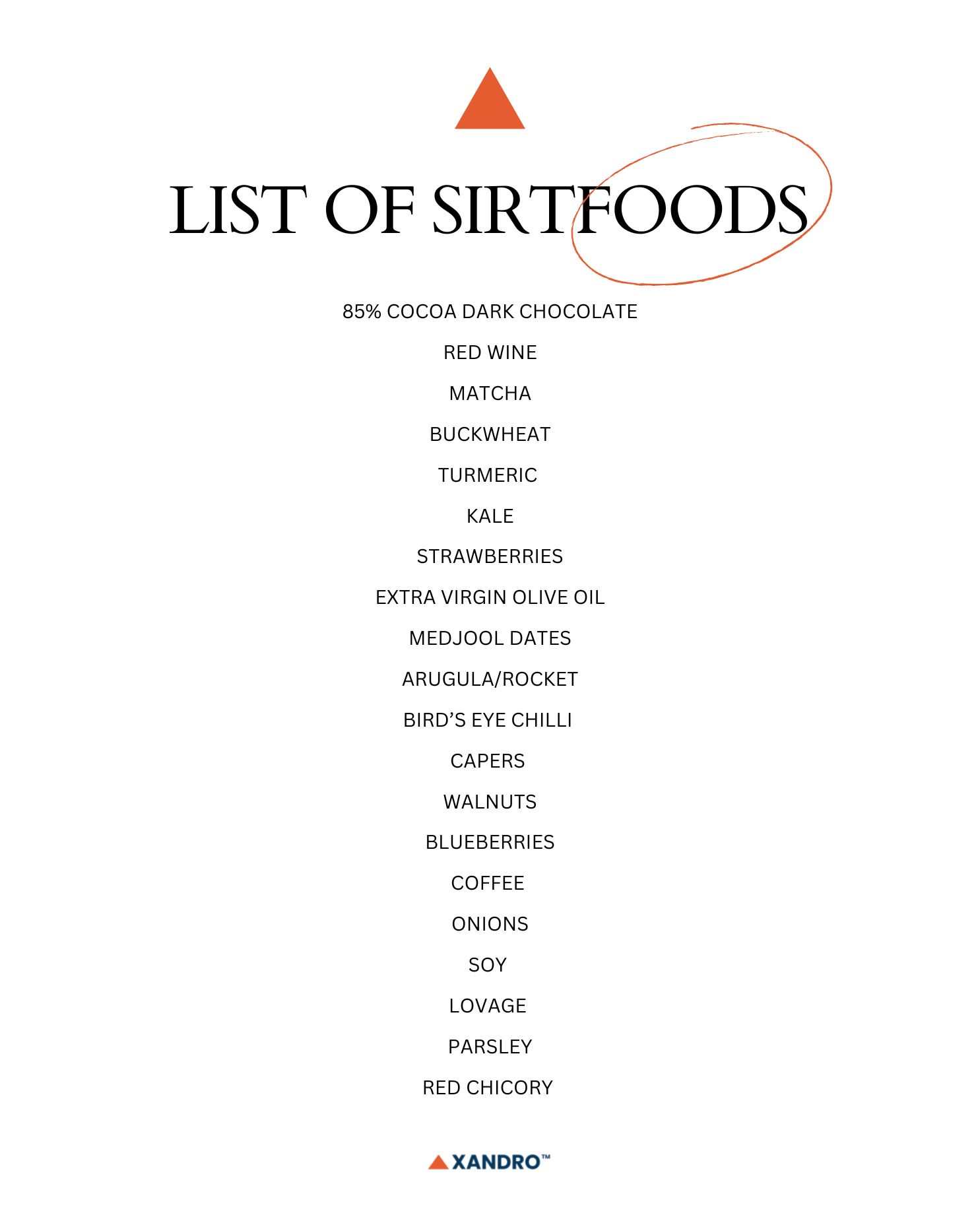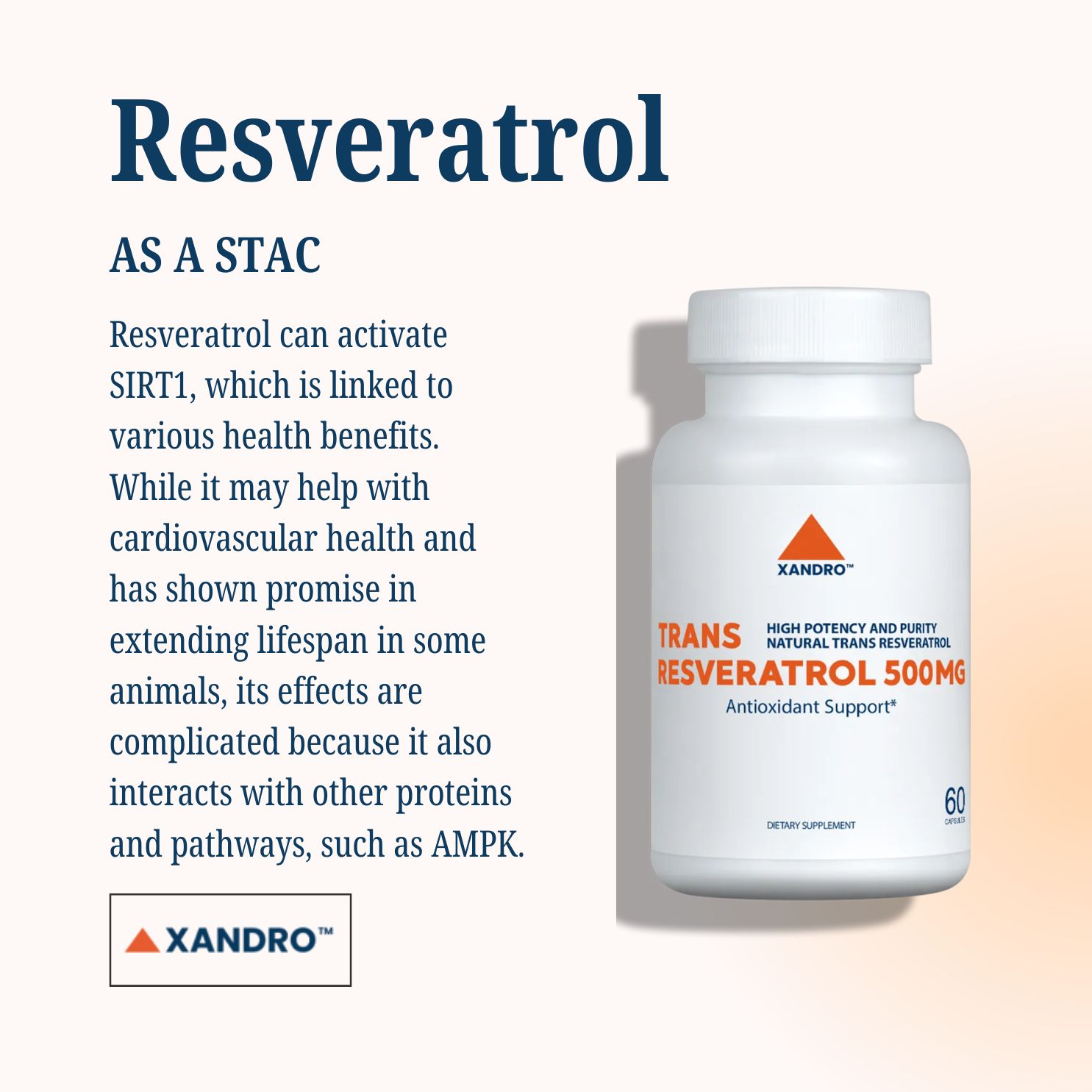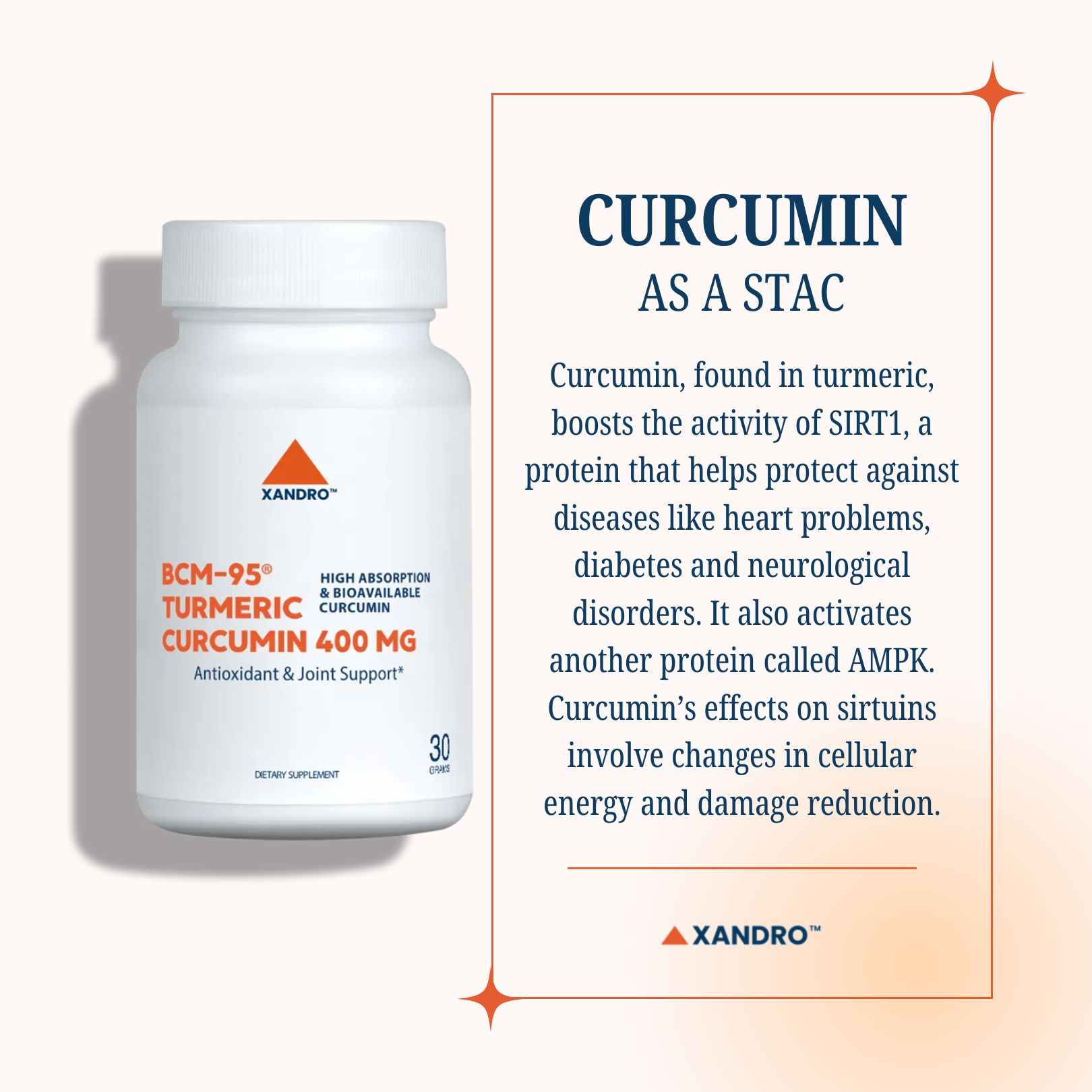What are the Activators of Sirtuins?
3rd Aug 2024
All About STACs + FAQs
Jump there now:
- What are Sirtuins Foods?
- What are the Activators of Sirtuins?
- Other Potential STACs
- Does Exercise Activate Sirtuins?
- End Note
Sirtuin activating compounds, otherwise known as STACs are chemicals that activate sirtuin enzymes. Boosting sirtuin activity may help treat diseases, help with weight loss and slow aging.
Research on STACs is growing, with some found naturally and others made synthetically. Some medications and specially designed chemicals can increase sirtuin activity. Certain foods and beverages, called ‘sirtfoods,’ contain natural STACs and are believed to improve health and weight loss, though clinical research is limited.
But what are sirtuins and what do they do?
Sirtuins are a group of seven essential proteins (SIRT1–7) crucial for human health. They regulate cell metabolism and gene expression and are known as ‘the guardians of the genome.’
Sirtuins help cells respond to stresses like oxidative and genotoxic stress. While their direct role in extending human lifespan is debated, a healthy lifestyle with regular exercise and a good diet can boost sirtuin levels, potentially enhancing healthspan. They have been shown to help regular metabolism and inflammation, too, so finding activators for sirtuins is a major area of research.
Does NAD+ activate sirtuins?
Sirtuins need the coenzyme NAD+ to function, but NAD+ levels decline with age, reducing sirtuin activity.
What are the 7 sirtuins?
There are seven sirtuins in humans, named SIRT1 to SIRT7. SIRT3, SIRT4, and SIRT5 are mainly in the mitochondria; SIRT1, SIRT6, and SIRT7 are mostly in the nucleus; and SIRT2 is in the cytoplasm, sometimes with SIRT1.
We talk more about sirtuins in our article: All About Sirtuins
As mentioned, sirtfoods are thought to help improve health and aid in weight loss, but what are they?
These are foods that can target sirtuins
You might have heard of the sirtfood diet due to it allowing people to have red wine and chocolate, but have you ever thought of why?
Now, if you’ve read a few of our articles, you would probably know just by seeing those two ingredients, and one of the reasons is due to them containing resveratrol.
The top 20 sirtfoods part of the diet include:
- 85% cocoa dark chocolate
- Red wine
- Matcha
- Buckwheat
- Turmeric
- Kale
- Strawberries
- Extra virgin olive oil
- Medjool dates
- Arugula/rocket
- Bird’s eye chilli
- Capers
- Walnuts
- Blueberries
- Coffee
- Onions
- Soy
- Lovage
- Parsley
- Red chicory
Many of these foods, such as dark chocolate, green tea and turmeric (through curcumin), have health benefits backing them up, so there’s no doubt that they should be added to your diet.
You will find that many of these ingredients contain compounds such as resveratrol, quinine, piceatannol and anthocyanidin, which are potential STACs, which we’ll talk about below.

Does fasting activate sirtuins?
Another aspect of the sirtfood diet is that it combines these ingredients with calorie restriction, which is thought to help the body produce higher levels of sirtuins.
Keep in mind that most forms of calorie restriction and fasting will help you achieve weight loss, so here at Xandro, we are not endorsing any particular diet. We’re just providing information and studies to inform you about various health topics.
When we fast or go through calorie restriction, sirtuins tell the body to burn more fat for energy and also improve insulin sensitivity, with animal studies showing higher sirtuin levels lead to fat loss.
Further Reading: Intermittent Fasting and Longevity
So, how do you activate sirtuins? Other than eating foods and limiting calories, you can also take supplements to activate sirtuins.
There are potentially more than 14,000 STACs identified from high-throughput screening and medical chemical efforts, and we will be going over some of the main ones below.
Sirtuins are thought to be key to longevity, making them a hot topic for anti-aging research. At this stage, research in animals to increase sirtuin protein levels shows exciting results, although more human research is needed.
Let’s go over some STACs!
Resveratrol
Is resveratrol and sirtuin activator?
A stilbene STAC, resveratrol is a polyphenol that comes from foods such as grape skins and red wine. It has potential cardiovascular benefits and has been found to activate SIRT1. Been shown to extend longevity in worms, flies, short-lived fish and worms, as well as improve health of unhealthy mice, although not in mice fed a standard diet.
Resveratrol, a commonly known SIRT1 activator, is nonspecific and interacts with many proteins, not just SIRT1. It also targets AMPK, phosphodiesterases and parts of the mitochondrial electron transport chain. This makes it challenging to determine which effects are due to SIRT1 activation versus other pathways.
Metformin, another longevity-promoting drug, similarly boosts SIRT1 activity by increasing NAD+ levels, which is similar to resveratrol's effect. Both resveratrol and AMPK can activate each other, depending on the dose.
A specific SIRT1 mutation (E230K) has been used to test the direct activation by STACs like resveratrol and synthetic compounds SRT1720 and SRT2014. These compounds didn't produce expected changes in cells with this mutation, showing that they specifically activate SIRT1 directly.
The effectiveness of resveratrol in clinical trials varies for several reasons. One is the choice of participants; those who are older or have insulin resistance tend to benefit the most, indicating that SIRT1 activation is most effective in restoring balance in unhealthy conditions. Resveratrol works best in obese mice, too. Another issue is that resveratrol and early STACs are hydrophobic, meaning they don't dissolve well or are not easily absorbed, affecting their efficacy. Interestingly, resveratrol might not need to reach all tissues to be beneficial; in rats, it activates SIRT1 in the gut, helping lower glucose levels without entering the bloodstream.
Keep in mind that resveratrol should be taken as trans-resveratrol to help with its absorption into the body. Have a look at Xandro Lab’s certified supplements and buy trans resveratrol today!

Quercetin
Quercetin, a natural antioxidant and anti-inflammatory found in fruits and vegetables, can activate SIRT6, a type of sirtuin protein, which helps protect against various diseases. Quercetin specifically activates SIRT6 by binding to a unique site on the protein and inhibits other sirtuin isoforms differently. It’s also an inhibitor of CD38, a glycohydrolase that degrades NAD+, which helps boost NAD+.
Isoquercetin, a related compound, selectively activates SIRT6 with increased specificity. Despite its benefits, quercetin has low solubility and bioavailability, making its medical use challenging.
Quercetin has also shown potential in reducing inflammation and oxidative stress, and improving cardiovascular and metabolic health.
More research is needed to determine its optimal dosage and administration for therapeutic use.
NAD+ Precursors
Nicotinamide mononucleotide (NMN) is a key precursor to NAD+, a crucial molecule for activating sirtuins, which play a vital role in metabolism and potentially increasing longevity. Since NAD+ itself is too large to be absorbed directly by the body, taking NMN supplements can effectively boost NAD+ levels. When NMN is consumed, the body converts it into NAD+, which in turn enhances sirtuin activity. This increased activity can improve metabolic functions and support overall cellular health.
NMN supplementation has been shown to significantly raise NAD+ levels, particularly in brain regions like the hippocampus. This boost in NAD+ helps increase the expression of SIRT1, a sirtuin involved in many beneficial cellular processes, and PGC-1α, a protein that supports energy metabolism. Additionally, NMN can reduce inflammation and oxidative stress, further protecting cells and promoting healthy aging.
Overall, NMN is a promising compound for supporting metabolism and longevity through its role in enhancing NAD+ and sirtuin activity.
Further Reading: Is Niacin as Effective as NMN as a NAD+ Precursor?
Curcumin
Does curcumin activate sirtuins?
Curcumin has antioxidant and anti-inflammatory properties that increase sirtuin-1 (SIRT1) activity. This upregulation protects against neurological disorders, heart issues, diabetes and lipid metabolism problems.
Curcumin activates AMPK and SIRT1, reducing cell death and damage. Low doses of curcumin extend life in certain organisms and activate sirtuins and AMPK, but one study showed that high doses can be harmful. Sirtuin activation by curcumin is linked to increased superoxide and reduced ATP. Low doses boost sirtuins without delaying cell aging.
Try out Xandro Lab’s highly absorbable Turmeric Curcumin!

Berberine
Berberine (BBR) is a compound found in plants with multiple health benefits. It has antioxidant, anti-inflammatory, anticancer and heart-protective properties. BBR can help stop cancer cell growth by causing cell cycle arrest and promoting apoptosis. It also reduces inflammation and oxidative stress, which can prevent damage to the heart and metabolic tissues.
BBR's effects are partly due to its activation of SIRT1, a protein that regulates many cellular processes, including lipid metabolism and antioxidant defence. Studies have shown that BBR, alone or combined with resveratrol (RSV), can lower cholesterol and triglyceride levels in mice, indicating its potential in treating metabolic disorders. Additionally, BBR protects the heart from damage caused by oxidative stress and inflammation, particularly in conditions like heart attacks and diabetes.
Clinical trials have tested BBR for its effectiveness in treating diabetes, high cholesterol and other metabolic diseases. The results are promising, suggesting that BBR could be a safe and effective treatment for reducing cardiovascular risk and improving metabolic health.
Fisetin
Fisetin is a natural polyphenol found in fruits and vegetables like strawberries, apples, grapes, onions and kale. Known for its anticancer, cardiovascular, anti-inflammatory and antioxidant properties, fisetin supports cell health and protection. It has shown neuroprotective effects in Huntington's disease models and can inhibit cancer growth pathways. Additionally, fisetin reduces heart damage from ischemia by lowering oxidative stress.
Fisetin activates key pathways, such as AMPK/SIRT1 and Nrf2, to counteract oxidative stress and regulate immune responses. It enhances SIRT1 expression, which helps reduce lipid accumulation and improve metabolic conditions like non-alcoholic fatty liver disease (NAFLD). Fisetin also acts as a caloric restriction mimetic, providing similar benefits to calorie restriction without needing to reduce food intake. This includes neuroprotective effects against aging and inflammation, making fisetin a promising candidate for treating neurological diseases and age-related conditions.
Currently, there are limited clinical trials exploring fisetin's benefits, with ongoing studies focusing on its anti-inflammatory effects in elderly individuals and those with osteoarthritis and chronic kidney diseases. These studies aim to confirm fisetin's potential as a therapeutic agent for various health issues.
Further Reading: Fisetin and its Longevity Potential
- SRT 1720, 1460 and 2183: These are synthetic STACs with conflicting studies of whether they directly activate sirtuins, particularly SIRT1.
- STAC-2, -5 and -9: STAC-2 is a thiazolopyridine while STAC-5 is a benzimidazole and STAC-9 a bridged urea. These synthetic STACs possibly activate SIRT1.
- SRT2104: The STAC SRT2104, which mimics calorie restriction and extends male mouse lifespan, has successfully passed multiple phase I trials with few side effects and is now in phase II trials. In clinical trials with elderly volunteers and healthy smokers, SRT2104 slightly reduced body weight, improved cholesterol ratios by 15-30%, and decreased triglyceride levels by 19%. Another study found that SRT2104 significantly reduced symptoms of plaque-type psoriasis after 84 days of treatment.
- Oleoyl-lysophosphatidic acid (LPA): Oleoyl-lysophosphatidic acid (LPA) significantly increases SIRT6 deacetylase activity by approximately 48-fold, enhancing its function. However, LPA also reduces the expression of Sirt1 protein.
- Butein: Butein is a natural compound known for its neuroprotective effects. It works by activating SIRT1, a protein that helps regulate cell health and longevity. By boosting SIRT1 activity, butein reduces inflammation and oxidative stress, which can protect neurons from damage.
- Quinine: Lab studies show that quinine is a potential SIRT1 activator, but human studies are needed.
- Piceatannol: Has been found to induce SIRT1 in human dermal fibroblasts, helping with skin structure.
- Cyanidin: Part of anthocyanidin found in red berries and has been found to increase SIRT6 activity 55-fold.
Exercise activates sirtuins, improving oxidative metabolism, mitochondrial function and the antioxidant system. This activation helps treat chronic conditions like metabolic syndrome, obesity, insulin resistance, and type 2 diabetes and supports longevity and healthy aging.
Aerobic exercise consistently boosts SIRT1 and SIRT3 in human skeletal muscle, especially at moderate to high intensities. Resistance training also benefits sirtuins but is less studied. Endurance training appears superior to resistance training in enhancing telomerase activity and telomere length, which support healthy aging. Research shows exercise, especially long-term, has positive effects on sirtuins, offering cardioprotective benefits and reducing oxidative stress.
Aerobic exercise increases SIRT1 and SIRT3, particularly in younger and middle-aged individuals, but not significantly in older ones. Strength sports don't seem to stimulate sirtuins or lengthen telomeres as effectively as aerobic exercise.
So, what is the best sirtuin activator?
At this stage, resveratrol is showing promising research as a STAC but ongoing research is exploring new STACs for human use, with over 50 clinical trials currently testing their safety and effects on diseases. These studies will help us understand how sirtuins impact human health!
Are you interested in certified supplements and healthcare products to help you with natural ways to get energy and improve your health? Xandro’s health nutrition store has some of the best energy products and supplements that will help you meet your longevity goals.
For example, you can buy NMN powder or capsules, curcumin and resveratrol supplements, or if you’re still doing your research, check out our research page and blog to keep yourself informed about your health!
